drawing 3d shapes from different views worksheet
Summary
Students acquire about isometric drawings and practise sketching on triangle-dot paper the shapes they make using multiple simple cubes. They also learn how to apply coded plans to envision objects and draw them on triangle-dot paper. A PowerPoint® presentation, worksheet and triangle-dot (isometric) newspaper printout are provided. This activity is part of a multi-action series towards improving spatial visualization skills.Engineering Connection
Spatial visualization is an essential skill in taking ideas that initially only exist in the mind to something that tin can be communicated clearly to other people and eventually turned into products, structures and systems. As such, it is an important skill for professionals within the science, applied science, technology and math (STEM) fields—particularly engineering. Engineers apply spatial visualization skills whenever iii-dimensional concepts, devices and ideas are existence discussed. For instance, chemic engineers use spatial visualization when studying iii-dimensional molecules, while mechanical engineers use spatial visualization when designing prosthetic limbs that require multiple motors, gears, linkages, bearings and shafts to fit inside a single assembly.
Learning Objectives
After this activity, students should be able to:
- Draw a coded plan from an object made of cubes.
- Apply a coded plan to build an object made of cubes.
- Define and explicate the pregnant of isometric.
- Draw a shape on isometric triangle-dot paper.
Educational Standards Each TeachEngineering lesson or activeness is correlated to one or more G-12 science, engineering, engineering science or math (STEM) educational standards.
All 100,000+ K-12 Stem standards covered in TeachEngineering are collected, maintained and packaged by the Achievement Standards Network (ASN), a project of D2L (www.achievementstandards.org).
In the ASN, standards are hierarchically structured: first by source; e.one thousand., past state; within source by blazon; due east.g., science or mathematics; inside type past subtype, then past grade, etc.
Each TeachEngineering lesson or activeness is correlated to one or more G-12 science, engineering, engineering science or math (STEM) educational standards.
All 100,000+ K-12 Stem standards covered in TeachEngineering are collected, maintained and packaged by the Achievement Standards Network (ASN), a project of D2L (www.achievementstandards.org).
In the ASN, standards are hierarchically structured: first by source; e.one thousand., past state; within source by blazon; due east.g., science or mathematics; inside type past subtype, then past grade, etc.
Mutual Core State Standards - Math
- Depict, construct, and draw geometrical figures and describe the relationships betwixt them. (Grade 7) More than Details
View aligned curriculum
Exercise you hold with this alignment? Thanks for your feedback!
- Verify experimentally the properties of rotations, reflections, and translations: (Grade 8) More Details
View aligned curriculum
Do you agree with this alignment? Thanks for your feedback!
- Apply geometric concepts in modeling situations (Grades 9 - 12) More Details
View aligned curriculum
Practise you agree with this alignment? Thanks for your feedback!
- Visualize relationships betwixt two-dimensional and iii-dimensional objects (Grades ix - 12) More Details
View aligned curriculum
Do you agree with this alignment? Cheers for your feedback!
- Place the shapes of 2-dimensional cantankerous-sections of three-dimensional objects, and place three-dimensional objects generated by rotations of ii-dimensional objects. (Grades 9 - 12) More Details
View aligned curriculum
Do you agree with this alignment? Thanks for your feedback!
State Standards
Colorado - Math
- Modeling geometric figures and relationships leads to informal spatial reasoning and proof. (Grade 7) More Details
View aligned curriculum
Practice yous agree with this alignment? Thank you for your feedback!
- Verify experimentally the properties of rotations, reflections, and translations. (Grade 8) More Details
View aligned curriculum
Do you agree with this alignment? Thanks for your feedback!
- Objects in the real world can be modeled using geometric concepts. (Grades nine - 12) More Details
View aligned curriculum
Exercise you concord with this alignment? Thanks for your feedback!
- Visualize relationships between 2-dimensional and three-dimensional objects. (Grades nine - 12) More than Details
View aligned curriculum
Do you concur with this alignment? Thanks for your feedback!
- Identify the shapes of two-dimensional cross-sections of three-dimensional objects, and identify three-dimensional objects generated by rotations of two-dimensional objects. (Grades 9 - 12) More Details
View aligned curriculum
Do y'all agree with this alignment? Thanks for your feedback!
Materials List
Each grouping needs:
- ten snap cubes (interlocking cubes); a set of 100 for $x-13 at https://www.amazon.com/Learning-Resources-LER4285-Mathlink-Cubes-100/dp/B000URL296 or https://www.amazon.com/Learning-Resources-LER7584-Snap-Cubes/dp/B000G3LR9Y
- pencil with eraser, for each student
- Blank Triangle-Dot Newspaper, two sheets per student
- Isometric Cartoon Worksheet, one per student
- (optional) computer with Internet access, to practice using the NCTM online isometric drawing tool at http://illuminations.nctm.org/Activeness.aspx?id=4182
To share with the entire course:
- (optional) computer with projector to show examples as provided in the Spatial Visualization Presentation, a PowerPoint® file; alternatively, draw or print out the examples for students
Worksheets and Attachments
Visit [www.teachengineering.org/activities/view/cub_spatviz_lesson01_activity1] to print or download.More than Curriculum Like This
Middle School Activity 
Seeing All Sides: Orthographic Drawing
Students learn how to create two-dimensional representations of 3-dimensional objects past utilizing orthographic projection techniques. They build shapes using cube blocks and then depict orthographic and isometric views of those shapes—which are the side views, such equally superlative, front, correct—with no de...

Middle Schoolhouse Lesson 
Permit'southward Learn about Spatial Viz!
In this lesson, students are introduced to the concept of spatial visualization and measure their spatial visualization skills by taking the provided 12-question quiz. Following the lesson, students complete the iv associated spatial visualization activities and then re-take the quiz to see how mu...

Center School Activity 
Let'south Have a Spin: One-Axis Rotation
Students acquire nigh i-centrality rotations, and specifically how to rotate objects both physically and mentally to empathise the concept. They do cartoon one-centrality rotations through a group exercise using cube blocks to create shapes and then drawing those shapes from various 10-, y- and z-axis ro...

Middle School Action 
New Perspectives: Ii-Axis Rotations
Students larn about ii-axis rotations, and specifically how to rotate objects both physically and mentally well-nigh ii axes. Students practice drawing two-axis rotations through an practise using simple cube blocks to create shapes, and then drawing on triangle-dot paper the shapes from various 10-, ...

Pre-Req Noesis
Earlier taking part in this spatial visualization activeness, students should have taken the Spatial Visualization Practise Quiz and learned about spatial visualization in the associated lesson, Allow's Learn about Spatial Viz!
Introduction/Motivation
(Have the slide presentation upwardly and displayed to the class, starting with slide iii.) Spatial visualization is useful for practicing engineers, has been shown to be a significant predictor of success for students in engineering, and is also a learned skill. That means nosotros can improve our spatial visualization skills by practicing. Today, we are going develop our skills in cartoon three-dimensional objects. Spatial visualization skills assistance you in many subjects and hobbies that require the imagination of three-dimensional shapes, such equally geometry, chemistry, physics, athletics (like tennis and gymnastics) and diverse reckoner games. Practicing spatial visualization enables you to empathize 3-dimensional figures and representations more than readily and perform ameliorate in these subjects and hobbies.
Role ane: Isometric Drawings
In the planning stage of any applied science project, an engineer needs to be able to accept the vision of a new design from within their head and illustrate information technology on a piece of paper or a computer screen. This procedure—visualizing the item equally a 3-dimensional object—includes the dimensions of depth, width and height. Without spatial visualization skills, engineers would exist unable to envision new ideas and communicate these ideas to others.
Isometric views are useful for displaying three-dimensional objects on a two-dimensional piece of paper. More than specifically, we utilise triangle-dot newspaper to draw objects isometrically. (Display slide 4, which is the aforementioned equally Figure 1.) This image shows a 3-D cube depicted in two different ways. On the left, the cube is fatigued not-isometrically in that the angles in the corners are not equal and the sides each have dissimilar areas. However, on the right, the cube is drawn such that the sides of the cube connect at a "corner," making equal angles of 120°. We telephone call this an isometric view of the cube. Also notice that in the illustration on the correct, all the sides of the cube are the same size. During this activity, we are going to practice drawing shapes isometrically. (Slide 5, same as Figure 4, shows a firm depicted isometrically using AutoCAD.)
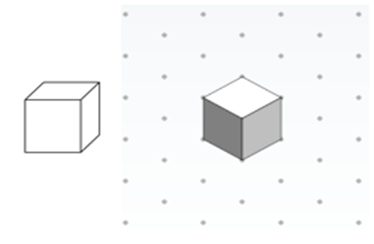
Part two: Coded Plans
Next, we are going to learn about coded plans. Before explaining coded plans, let's practise an activity that demonstrates the importance of using coded plans. First, squad upward with a person next to y'all.
(Direct the grade through the following exercise: Take partner #1 shut their eyes. Prove all partner #2 students the left epitome in slide 6, which is the same equally Figure ii. Inform partner #i to keep their eyes closed while partner #2 describes the paradigm. Let the object clarification proceed for a couple of minutes. When finished, have partner #i draw the object every bit accurately every bit possible.)
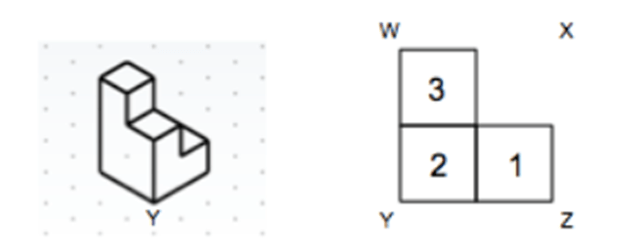
For such a simple-appearing object, that was pretty challenging, right? Possibly you lot described the object using phrases similar these:
- It is made of six cubes.
- Three cubes are stacked, one on top of the other. Adjacent to that are two cubes, also stacked one on superlative of the other. Adjacent to that stack is one single cube.
Even with this explanation, information technology is possible that your partner incorrectly envisioned the object. Imagine if you were an engineer who needed to design a much more complicated object than the one you tried to describe—it would be fifty-fifty more difficult! This is precisely why we use coded plans in applied science drawings. Coded plans are a type of tool used past engineers to limited 3-dimensional objects on two-dimensional surfaces. A coded plan defines the shape of a structure or object composed of blocks. (Click to reveal the right side of slide 6, which is the aforementioned as the right side of Effigy 2—a coded plan of the same image merely described and fatigued by students.) For case, a coded plan is shown here. Observe that the corners of the object are labeled by messages. Notice also that the numbers inside the squares represent the number of cubes that are stacked on top of each other. Next, we will exercise some activities to practice making coded plans and isometric drawings.
Process
Groundwork
The term "isometric" literally means "equal measure." In other words, when nosotros isometrically describe an object composed of multiple cubes, the cube faces are all the same area and the corner angles are all equal and 120°. Triangle-dot paper is useful because the dots are situated 120° from each other, which facilitates drawing three-D objects. For students only starting to exercise spatial visualization, it is benign to use toy blocks with the ability to interlock and form larger shapes composed of the cubes (such as the recommended "snap cubes" in the Materials List; see Figure three.)
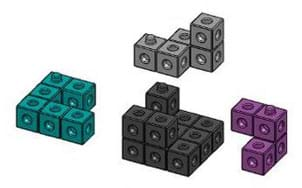
Engineers use computer-aided drafting software programs such as AutoCAD® to create blueprints and design plans. Figure 4 (also on slide v) shows a house that was depicted isometrically using AutoCAD.
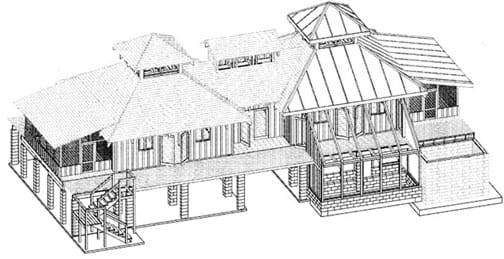
Before the Activity
- Gather materials and brand copies of the Blank Triangle-Dot Paper and Isometric Drawing Worksheet.
- (optional) Decide if yous want to incorporate having students practice with the NCTM online isometric drawing tool that enables them to draw their own isometric objects and rotate the objects around the ten-, y- and z-planes.) If and then, arrange for and set up estimator and Internet access to do so.
- Ready to project the Spatial Visualization Presentation, a PowerPoint® file, and use its content to aid in your instruction, as makes sense for your class. Slides 3-11 back up this activity. The slides are animated and so a mouse or keyboard click brings up the next graphic or text.
With the Students: Introduction
- Nowadays to the grade the Introduction/Motivation content, supported past slides 3-6. Besides enquire the pre-cess question, as described in the Cess section.
- Divide the class into groups of two students each.
- Hand out two pieces of triangle dot newspaper to each pupil and 10 cubes to each pair. Explain that students are to share their interlocking cubes with their partners, primarily work independently on their drawings, but experience free to share their drawings and troubleshoot with their partners. Instruct students to work on ane piece of triangle-dot paper until it is full.
Part ane. Basics of Cartoon Cubes on Triangle-Dot Paper
- Equally a form, directly students to each put one cube on the desk in front of themselves. Ask the students to draw their cubes on isometric paper (individually). To brainstorm with, direct them to motility sequentially through the drawing using the following steps. (Every bit makes sense, also show the drawing tips on slide 7.)
- Draw a dot representing a corner of the cube.
- Draw lines that represent the edges of the cube that connect to that corner.
- Draw a single surface of the cube.
- Complete all other surfaces of the cube.
- Once finished, accept students share their drawings with their partners. Expect the drawings to resemble the left-most image in slide 8 (same every bit Effigy 5-far left; click the mouse/keyboard to reveal it).
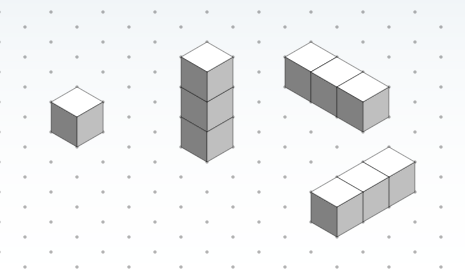
Figure 5. Various cube shapes fatigued on triangle-dot paper. -
Have students stack two blocks on tiptop of the original block to form a iii-cube "belfry." Ask them to depict the stacked cubes on isometric paper and and then share with their partners. Look their drawings to resemble the center image in slide 8 (same as Figure v-eye; click the mouse/keyboard to reveal information technology).
-
Finally, have students turn their towers on their sides so that three cubes are touching the desk/table surface. Now, enquire the students to describe the stacked belfry at this angle on isometric newspaper. Await their drawings to resemble ane of the 2 images on the right side of slide eight (same as Figure 5-far right; click the mouse/keyboard to reveal information technology), depending on which way they oriented the object.
-
At this bespeak, stop and brand sure that all students are getting the hang of drawing on isometric triangle-dot paper. If students are struggling, spend more than time on the first iii steps. If necessary, display the answers for the class and/or demonstrate how to draw each of the three images. Find how the faces in betwixt the cubes and the backside/bottom of each cube are not drawn directly; we know that those sides are part of the cubes, but the isometric drawing cannot depict all details of a 3-D object.
Part 2. Cartoon Shapes of Increased Complexity on Triangle-Dot Newspaper
- Direct the students to each use 4 blocks to make a shape of their choosing.
- Inquire the students to individually describe the shapes of their objects on isometric paper.
- Accept partners switch objects and draw the shape of their partners' objects.
- Once both partners are finished cartoon the objects they created, too as the objects created past their partners, have them cross-cheque their drawings to brand sure that they are correct.
- Have students repeat the four previous steps, calculation one more than cake to their shapes for each iteration. Permit students to continue working for near v minutes. If they are working through these steps rapidly, see the Extension Activities department for ways to challenge them further.
- Assign students to consummate the worksheet. Find and assist as necessary.
(optional) Part iii. Drawing Isometric Views from Coded Plans
Every bit an optional/extra credit assignment, present to students the following peer teach exercise:
- Yet in pairs, show students the drawing tips on slide 9.
- And so evidence students the coded programme shown to the far left on slide x (same as Figure half-dozen-far left. Inquire them to draw 2 different isometric views of the coded plan. Information technology may be necessary to rotate a sample cube shape to assistance students to understand this challenge. Click on slide 10 to reveal the solutions to the four possible isometric views.
- One time each pupil has drawn ii isometric views, accept educatee pairs explain to each other how they produced their drawings.

Vocabulary/Definitions
coded plan: A spatial visualization term that refers to a method of describing a three-dimensional shape ii-dimensionally.
isometric: Of or having equal dimensions. The isometric view of an object is the bending at which an equal angle (120°) exists between all axes (such as looking down a corner of the object).
spatial visualization: The ability to mentally manipulate two- and three-dimensional objects. It is typically measured with cognitive tests and is a predictor of success in STEM fields. Also referred to every bit visual-spatial ability.
triangle-dot newspaper: A grid of dots arranged equidistant from 1 another. Used in making isometric sketches. Also called isometric paper.
Assessment
Pre-Activity Assessment
Question/Respond: Ask students: Why are isometric drawings important to engineers? (Signal to make: Isometric drawings correspond three-dimensional objects on a two-dimensional surface. By doing this, engineers tin can draw complicated three-D objects in a way that is piece of cake to share and describe. Without isometric drawings, engineers would require 3-D models of each idea/concept, which would be costly, cumbersome and inconvenient.)
Activity Embedded Cess
Worksheet: After completing the classroom pedagogy on isometric drawing, assign students to complete the Isometric Drawing Worksheet. Detect whether students are able to depict the rotated objects or if they are struggling. Assist them if necessary. Review their answers to gauge their depth of understanding.
Post-Activity Assessment
Discussion: Ask students to explain and describe their drawings with specific focus on the isometric concept. What strategies did they utilize to draw their cube shapes? What were the limitations they experienced, if whatsoever? How did students solve any drawing challenges? Since anybody has worked through the same exercises, group sharing of their challenges and approaches informs the teacher of students' depth of understanding and provides their peers with relevant ideas and tips.
Activity Extensions
- Have students rotate one of their snap cake objects to come across how many new angles they tin can draw information technology from. Show slide 11 (aforementioned as Figure 7) as an instance.
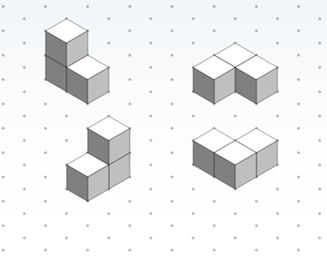
- Have students rotate a shape in their minds and draw it on triangle-dot newspaper without physically rotating whatsoever cubes/shapes.
- Have each partner use four cubes to brand a shape and identify the object under their partners' chairs without showing the shape. Then, have students reach under their chairs and experience the objects (without looking at them) and draw the shapes they felt. Once finished, have them compare their drawings to the objects.
- Have students depict the uppercase letters Due east and T in isometric view; show slide 11 as an example (same as Figure eight).
- Ask students to calculate the book and expanse of 1 of the shapes they drew. To assist with the challenge, tell them that the length of one side of a cube is 5 cm.
Action Scaling
- For lower grades, guide students through drawing the cube shapes by using an overhead projector. Depending on how much guidance is needed, repeat Part 1 for other very simple shapes.
- For higher grades, claiming students to comport all the Activity Extensions.
Boosted Multimedia Support
Accept students practice with the NCTM online isometric drawing tool to draw isometric objects and rotate the objects around the X, Y and Z planes: http://illuminations.nctm.org/Activeness.aspx?id=4182.
Copyright
© 2011 by Regents of the Academy of ColoradoContributors
Emily C. Gill; Jacob Segil; Emily BreidtSupporting Program
Applied science Plus Caste Plan, University of Colorado BoulderAcknowledgements
This activity was developed by the Engineering science Plus degree programme in the College of Applied science and Applied Scientific discipline at the University of Colorado Boulder.
This lesson plan and its associated activities were derived from a summertime workshop taught by Jacob Segil for undergraduate engineers at the Academy of Colorado Boulder. The activities take been adapted to suit the skill level of center school students, with suggestions on how to conform activities to elementary or, in some instances, high school level.
Last modified: March 2, 2022
Source: https://www.teachengineering.org/activities/view/cub_spatviz_lesson01_activity1
0 Response to "drawing 3d shapes from different views worksheet"
Post a Comment